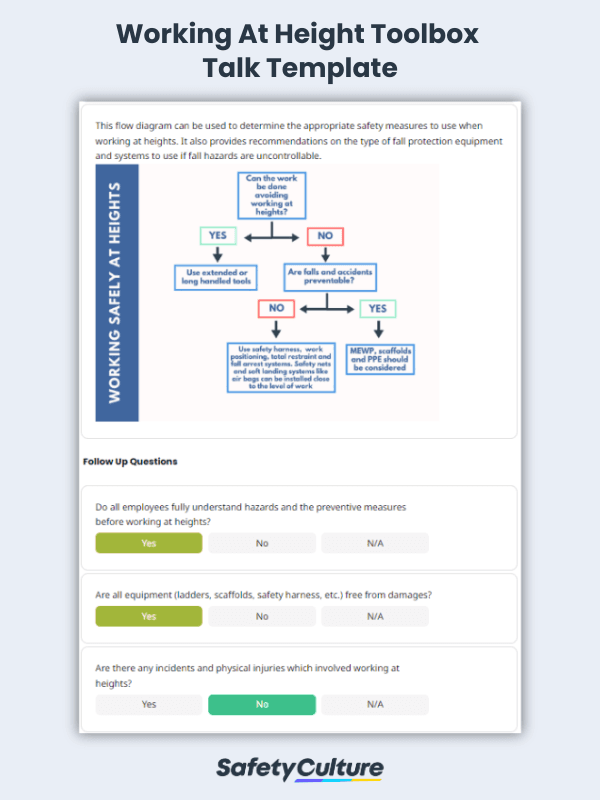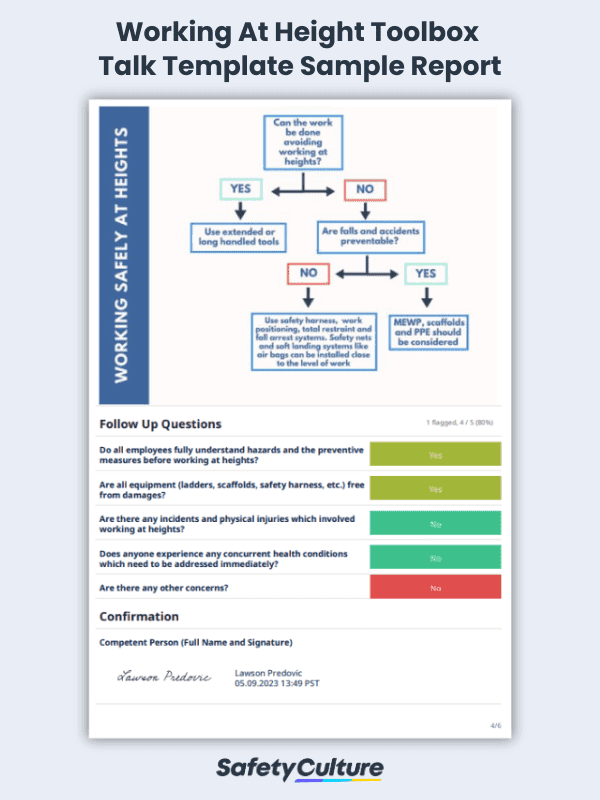What is a Working At Height Toolbox Talk Template?
A working at height toolbox talk template is used to cover brief discussion points for workers to promote safety measures while working at heights. The goal of the checklist is to help understand the hazards and the preventive measures before commencing work.
Importance and Benefits
A working at height toolbox talk template is unlike a checklist in the form of a paper document. With this digital checklist, you are able to be much more effective in conducting your safety toolbox talks and ensure that you cover everything you need. With a digital checklist, you will also be able to ensure that your toolbox talk will cover safety regulations and keep everyone in your team aware of these standards.
Here are some of the benefits of using a template for carrying out working at height toolbox talks:
Adhere to Safety Regulations and Standards
Numerous safety regulations and standards are in place to protect workers. These regulations vary from country to country, but generally, they aim to minimize the risks associated with elevated work. Common regulations include specifying the type of safety equipment required, training requirements, and inspection protocols.
Fulfill the Responsibilities of Employees and Employers
Both employees and employers have crucial roles to play in ensuring safety when working at height. Employees must undergo proper training, use safety equipment as directed, and report any unsafe conditions. Employers, on the other hand, are responsible for providing appropriate safety training, maintaining equipment, and conducting regular safety assessments.
Avoid the Consequences of Non-compliance
Non-compliance with working at height regulations can have severe consequences. This may include fines, legal actions, and, most importantly, accidents resulting in injury or loss of life. To avoid non-compliance, the organization must always adhere to safety regulations and utilize tools like this template.
How to Use This Checklist in a Toolbox Talk
Using this checklist is straightforward as you prepare and conduct your working at height toolbox safety talk. Here’s a step-by-step guide on how to run through your toolbox talk with this template:
- Add basic information about the location, site, project details, and personnel involved.
- List down all potential hazards on site as much as possible.
- Run through the discussion points with your workers, starting from potential hazards to working at heights planning and, lastly, provide safety tips.
- Demonstrate a flow diagram when applicable. This helps your workers better understand safety measures before conducting commencing work at heights.
- Conduct a Q&A and see if all participants have understood the discussion points and address any additional concerns if any.
- Inspect all equipment if they are free from damage. Create an action item if in need of replacement.
- Conclude the toolbox talk and finish the checklist by signing at the end of the checklist. Any issues encountered during the process may be assigned to a responsible person to take action if urgent.
A finished checklist will provide you with a brief report of what you completed, anything you missed, and items that require attention and action.
Working at Height Toolbox Talk Template Frequently Asked Questions (FAQs)
Anyone involved in tasks that require working at height should participate, including workers, supervisors, and managers. It’s essential to have everyone on the same page regarding safety procedures and expectations.
A common schedule to conduct a toolbox talk ideally is weekly or monthly, depending on the level of risk associated with the work and the size of your organization. In general, they should be conducted regularly, especially before starting new tasks or when there are changes in safety procedures or equipment.
Topics to cover may include identifying potential hazards, selecting the right equipment, proper use of safety gear, emergency procedures, and compliance with relevant regulations. The specific content will depend on the nature of the tasks and the industry.




